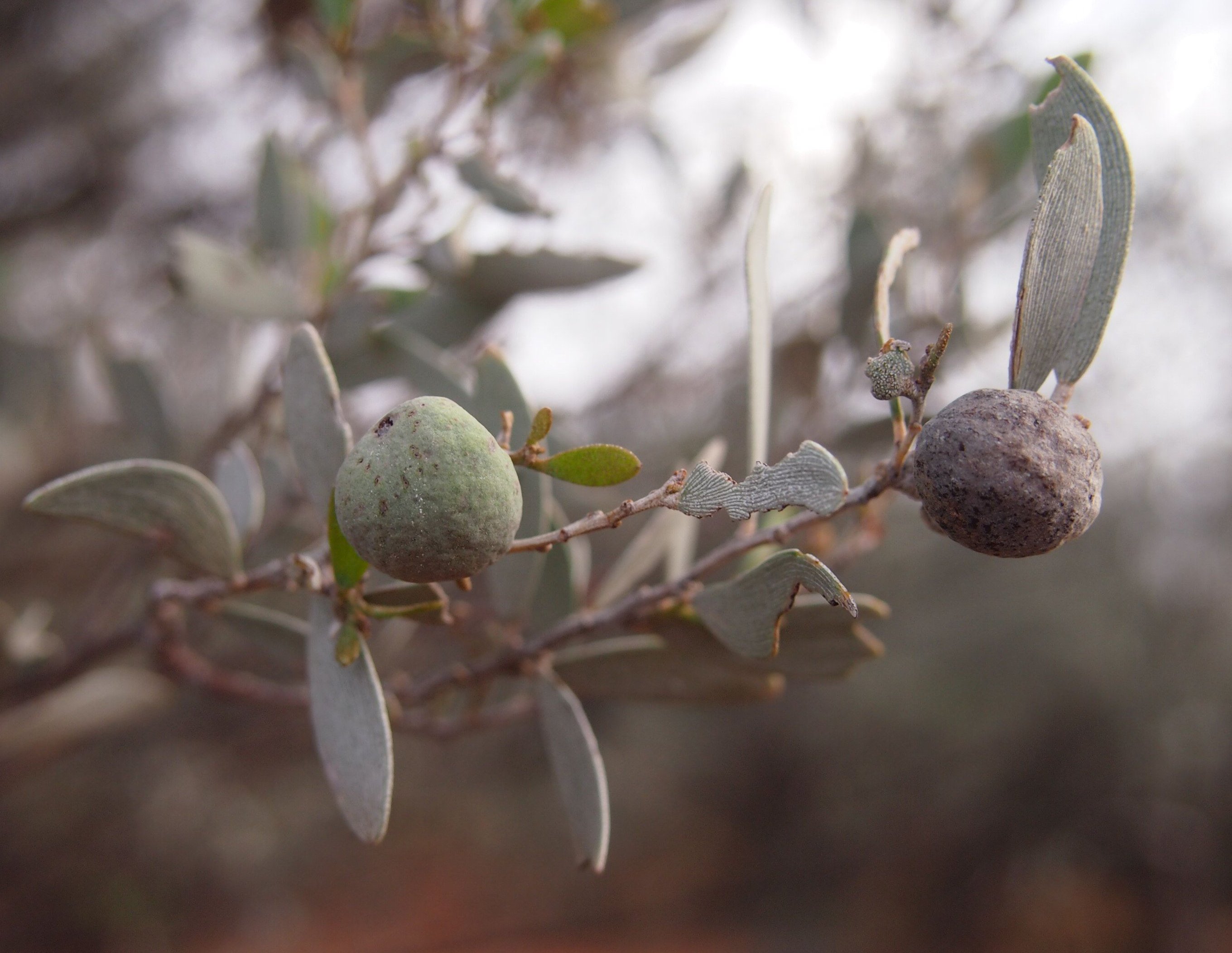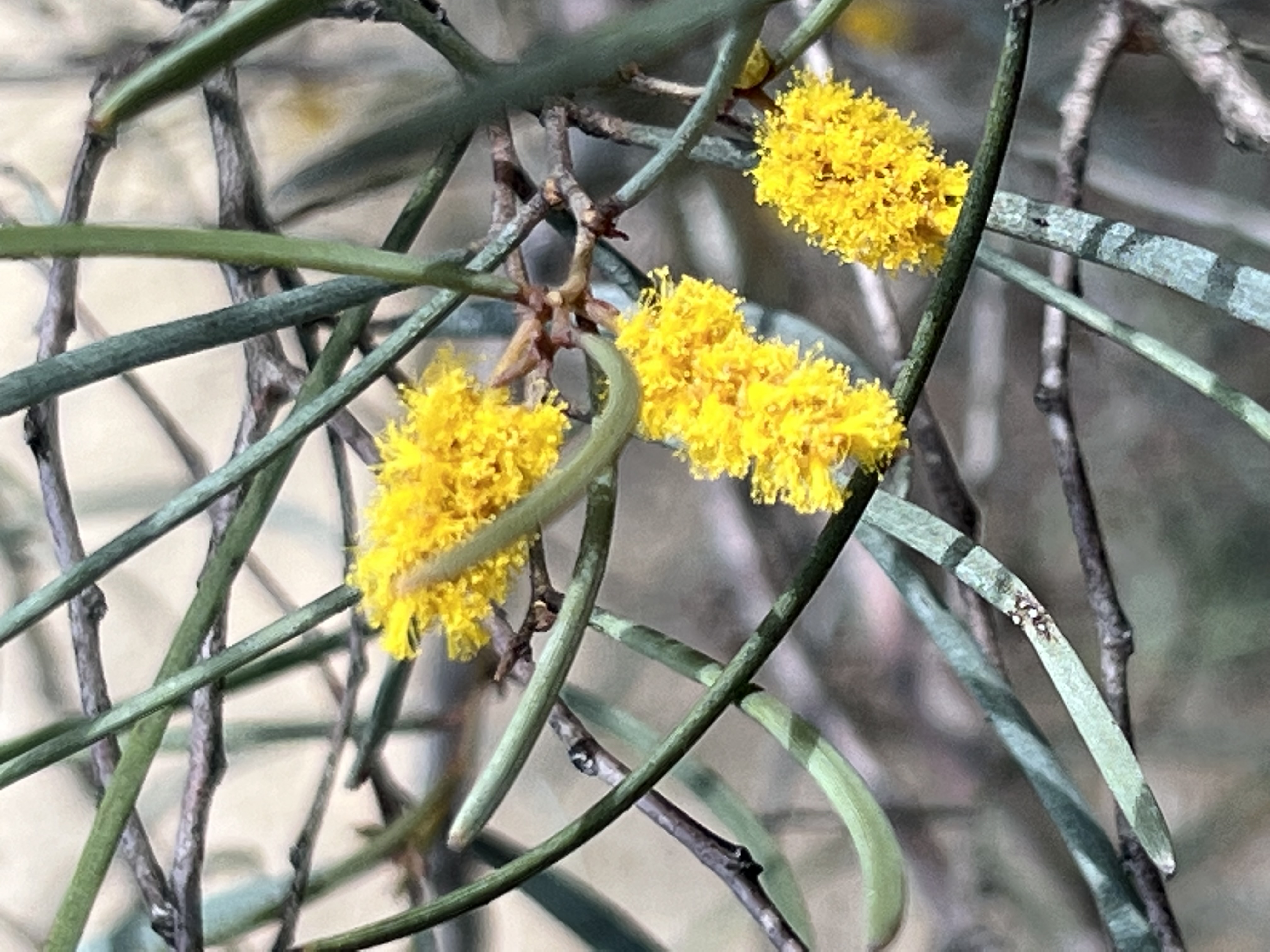|
Mulga Apple
The mulga apple is an Australian bush tucker food, often eaten by the Indigenous Australians of Central Australia. The mulga apple is in fact a combination of plant and animal; the insect gall grows inside the wood of the mulga tree ''(Acacia aneura''). Without the wasp the gall would not be induced. Mulga apple is known as ''Merne ataltyakwerle'' in the Arrernte language of Central Australia. Mulga trees grow in flat country and at the foot of hills. It grows on the end of the mulga branches. Aboriginal Australians eat them raw or cook them in hot earth. The wasp larvae are also eaten. The taste is said to be sweet and like apples. See also *Bush coconut The bush coconut, or bloodwood apple, is an bushfood, Australian bush tucker food. It is an insect gall with both plant and animal components: an adult female scale insect and her offspring (of genus ''Cystococcus'') live in a gall induced on ... References {{DEFAULTSORT:Mulga Apple Bushfood Australian Aboriginal ... [...More Info...] [...Related Items...] OR: [Wikipedia] [Google] [Baidu] |
Australia
Australia, officially the Commonwealth of Australia, is a country comprising mainland Australia, the mainland of the Australia (continent), Australian continent, the island of Tasmania and list of islands of Australia, numerous smaller islands. It has a total area of , making it the list of countries and dependencies by area, sixth-largest country in the world and the largest in Oceania. Australia is the world's flattest and driest inhabited continent. It is a megadiverse countries, megadiverse country, and its size gives it a wide variety of landscapes and Climate of Australia, climates including deserts of Australia, deserts in the Outback, interior and forests of Australia, tropical rainforests along the Eastern states of Australia, coast. The ancestors of Aboriginal Australians began arriving from south-east Asia 50,000 to 65,000 years ago, during the Last Glacial Period, last glacial period. By the time of British settlement, Aboriginal Australians spoke 250 distinct l ... [...More Info...] [...Related Items...] OR: [Wikipedia] [Google] [Baidu] |
Bush Tucker
Bush tucker, also called bush food, is any food native to Australia and historically eaten by Indigenous Australians and Torres Strait Islander peoples, but it can also describe any native flora, fauna, or fungi used for culinary or medicinal purposes, regardless of the continent or culture. Animal native foods include kangaroo, emu, witchetty grubs and crocodile, and plant foods include fruits such as quandong, kutjera, spices such as lemon myrtle and vegetables such as warrigal greens and various native yams. Traditional Indigenous Australians' use of bushfoods has been severely affected by the colonisation of Australia beginning in 1788 and subsequent settlement by non-Indigenous peoples. The introduction of non-native organisms, together with the loss of and destruction of traditional lands and habitats, has resulted in reduced access to native foods by Aboriginal people. Since the 1970s, there has been recognition of the nutritional and gourmet value of native foods ... [...More Info...] [...Related Items...] OR: [Wikipedia] [Google] [Baidu] |
Indigenous Australians
Indigenous Australians are people with familial heritage from, or recognised membership of, the various ethnic groups living within the territory of contemporary Australia prior to History of Australia (1788–1850), British colonisation. They consist of two distinct groups, which include many ethnic groups: the Aboriginal Australians of the mainland and many islands, including Aboriginal Tasmanians, Tasmania, and the Torres Strait Islanders of the seas between Queensland and Papua New Guinea, located in Melanesia. 812,728 people Aboriginality, self-identified as being of Aboriginal and/or Torres Strait Islander origin in the 2021 Australian Census, representing 3.2% of the total population of Australia. Of these Indigenous Australians, 91.4% identified as Aboriginal, 4.2% identified as Torres Strait Islander, and 4.4% identified with both groups. The term Aboriginal and Torres Strait Islander peoples or the person's specific cultural group, is often preferred, though the term ... [...More Info...] [...Related Items...] OR: [Wikipedia] [Google] [Baidu] |
Central Australia
Central Australia, also sometimes referred to as the Red Centre, is an inexactly defined region associated with the geographic centre of Australia. In its narrowest sense it describes a region that is limited to the town of Alice Springs and its immediate surrounds including the MacDonnell Ranges. Commonly, it refers to an area up to from Alice Springs, in every direction. In its broadest use it can include almost any region in inland Australia that has remained relatively undeveloped, and in this sense is synonymous with the term Outback. In a modern, more formal sense it can refer to the administrative region used by the Northern Territory government, as of 2022. Centralia is another term associated with the area, most commonly used by locals. Administrative region of the NT Economic region There are six regions in the Northern Territory for the purposes of economic planning, as defined by the Northern Territory Government: * Central Australia * Darwin, Palmersto ... [...More Info...] [...Related Items...] OR: [Wikipedia] [Google] [Baidu] |
Gall
Galls (from the Latin , 'oak-apple') or ''cecidia'' (from the Greek , anything gushing out) are a kind of swelling growth on the external tissues of plants. Plant galls are abnormal outgrowths of plant tissues, similar to benign tumors or warts in animals. They can be caused by various parasites, from viruses, fungi and bacteria, to other plants, insects and mites. Plant galls can be such highly organized structures that their cause can be determined without the actual agent being identified. This applies particularly to insect and mite plant galls. The study of plant galls is known as cecidology. Anatomy Shape and size Galls develop on various plant organs, providing nutrition and shelter to inducing insects. Galls display vast variation in morphology, size, and wall composition. The size of insect galls can range significantly, from approximately two inches in diameter to less than one-sixteenth of an inch. Some galls are so small that they are merely slightly thick ... [...More Info...] [...Related Items...] OR: [Wikipedia] [Google] [Baidu] |
Acacia Aneura
''Acacia aneura'', commonly known as mulga, is a species of flowering plant in the family Fabaceae and is endemic to inland Australia. It is a variable shrub or small tree with flat, narrowly linear to elliptic phyllodes, cylindrical spikes of bright yellow flowers and more or less flat and straight, leathery Pod (fruit), pods. Description ''Acacia aneura'' is a variable shrub or small tree that typically grows to a height of , sometimes up to and is often multistemmed with a bushy Crown (botany), crown. Its phyllodes are flat, narrowly linear to narrowly elliptic, long and mostly wide, straight or slightly curved. The flowers are borne in a cylindrical head in the axils of phyllodes on a hairy Peduncle (botany), peduncle long. The heads are long and bright yellow. Flowering occurs from March to May or August and the pod is more or less straight and flat, long and wide with a winged edge. The pods are papery, brown to greyish-brown, containing elliptic to oblong or e ... [...More Info...] [...Related Items...] OR: [Wikipedia] [Google] [Baidu] |
Arrernte Language
Arrernte or Aranda (; ), or sometimes referred to as Upper Arrernte (Upper Aranda), is a dialect cluster in the Arandic language group spoken in parts of the Northern Territory, Australia, by the Arrernte people. Other spelling variations are Arunta or Arrarnta, and all of the dialects have multiple other names. There are about 1,800 speakers of Eastern/Central Arrernte, making this dialect one of the widest spoken of any Indigenous language in Australia, the one usually referred to as Arrernte and the one described in detail below. It is spoken in the Alice Springs area and taught in schools and universities, heard in media and used in local government. The second biggest dialect in the group is Alyawarre. Some of the other dialects are spoken by very few people, leading to efforts to revive their usage; others are now completely extinct. Arrernte/Aranda dialects "Aranda" is a simplified, Australian English approximation of the traditional pronunciation of the name of '' ... [...More Info...] [...Related Items...] OR: [Wikipedia] [Google] [Baidu] |
Bush Coconut
The bush coconut, or bloodwood apple, is an bushfood, Australian bush tucker food. It is an insect gall with both plant and animal components: an adult female scale insect and her offspring (of genus ''Cystococcus'') live in a gall induced on a bloodwood eucalypt tree (''Corymbia''). Bush coconuts can vary from golf ball to tennis ball size. They have a hard and lumpy outer layer. The inner layer is a white flesh that contains the female insect and her offspring. There are three known species of ''Cystococcus'' responsible for forming the bush coconut: ''Cystococcus pomiformis'', ''Cystococcus echiniformis'' and ''Cystococcus campanidorsalis''. ''C. pomiformis'' is the most common species. The bush coconut is found in Western Australia, the Northern Territory, Queensland and New South Wales. The bush coconut is picked from the Host (biology), host tree and cracked open to allow the flesh and scale insects to be eaten. Both have a high Protein, protein content and are used as a ... [...More Info...] [...Related Items...] OR: [Wikipedia] [Google] [Baidu] |
Bushfood
Bush tucker, also called bush food, is any food native to Australia and historically eaten by Indigenous Australians and Torres Strait Islander peoples, but it can also describe any native flora, fauna, or fungi used for culinary or medicinal purposes, regardless of the continent or culture. Animal native foods include kangaroo, emu, witchetty grubs and crocodile, and plant foods include fruits such as quandong, kutjera, spices such as lemon myrtle and vegetables such as warrigal greens and various native yams. Traditional Indigenous Australians' use of bushfoods has been severely affected by the colonisation of Australia beginning in 1788 and subsequent settlement by non-Indigenous peoples. The introduction of non-native organisms, together with the loss of and destruction of traditional lands and habitats, has resulted in reduced access to native foods by Aboriginal people. Since the 1970s, there has been recognition of the nutritional and gourmet value of native foods ... [...More Info...] [...Related Items...] OR: [Wikipedia] [Google] [Baidu] |
Australian Aboriginal Bushcraft
Australian(s) may refer to: Australia * Australia, a country * Australians, citizens of the Commonwealth of Australia ** European Australians ** Anglo-Celtic Australians, Australians descended principally from British colonists ** Aboriginal Australians, indigenous peoples of Australia as identified and defined within Australian law * Australia (continent) ** Indigenous Australians * Australian English, the dialect of the English language spoken in Australia * Australian Aboriginal languages * ''The Australian'', a newspaper * Australiana, things of Australian origins Other uses * Australian (horse), a racehorse * Australian, British Columbia, an unincorporated community in Canada See also * The Australian (other) * Australia (other) * * * Austrian (other) Austrian may refer to: * Austrians, someone from Austria or of Austrian descent ** Someone who is considered an Austrian citizen * Austrian German dialect * Something associated with the count ... [...More Info...] [...Related Items...] OR: [Wikipedia] [Google] [Baidu] |
Insects As Food
Insects as food or edible insects are insect species used for human consumption. Over 2 billion people are estimated to eat insects on a daily basis. Globally, more than 2,000 insect species are considered edible, though far fewer are discussed for industrialized mass production and regionally authorized for use in food. Many insects are highly nutritious, though nutritional content depends on species and other factors such as diet and age. Insects offer a wide variety of flavors and are commonly consumed whole or pulverized for use in dishes and Food processing, processed food products such as burger patties, pasta, or snacks. Like other foods, there can be risks associated with consuming insects, such as allergic reactions. As commercial interest in insects as food grows, countries are introducing new regulatory frameworks to oversee their production, processing, marketing, and consumption. Edible insects Frequently consumed insect species Human consumption of 2,205 diffe ... [...More Info...] [...Related Items...] OR: [Wikipedia] [Google] [Baidu] |





